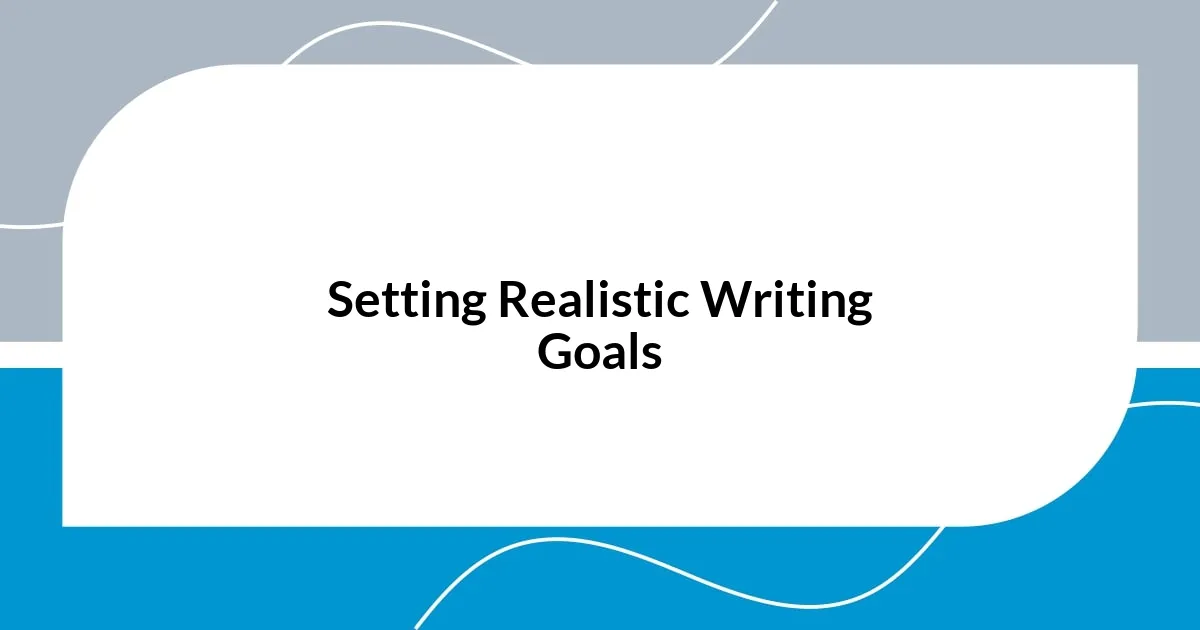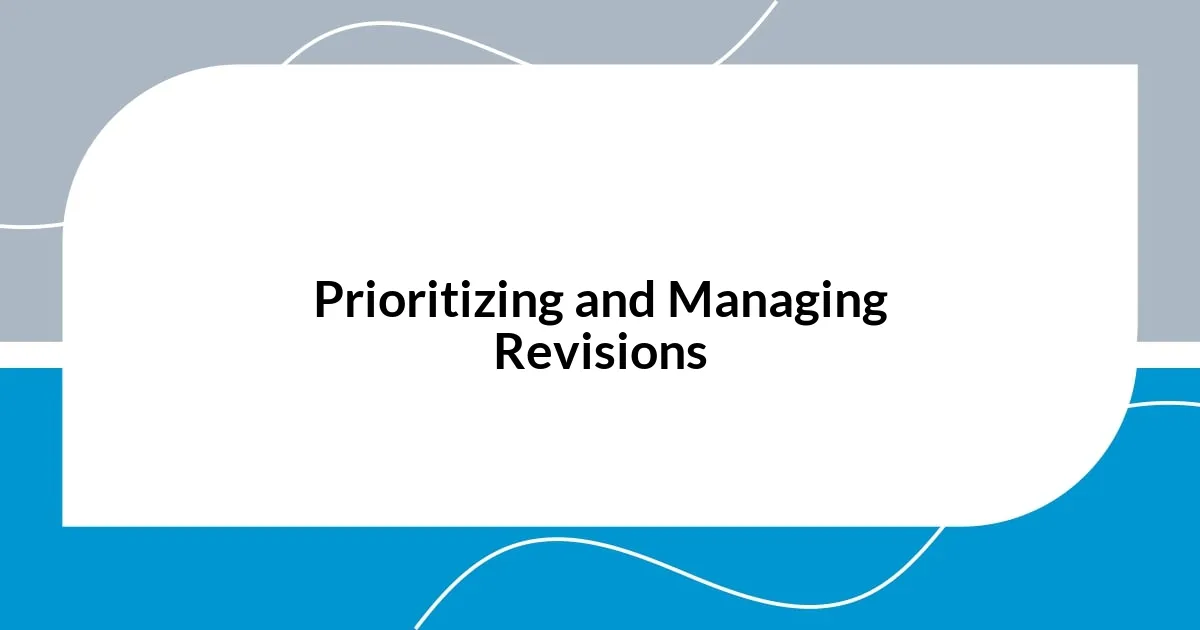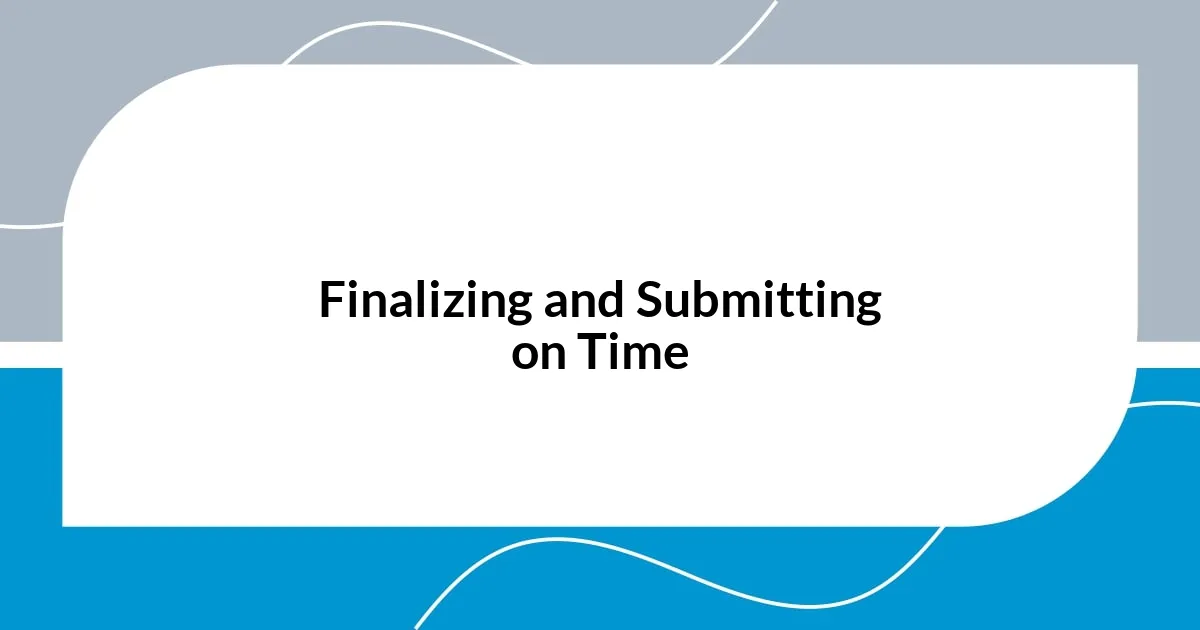Key takeaways:
- Break down writing tasks into manageable chunks to alleviate stress and maintain motivation.
- Set realistic writing goals and regularly reevaluate them to adapt to changing circumstances.
- Create a detailed writing schedule with specific timelines for drafts, revisions, and buffer time for unforeseen delays.
- Use project management tools to track progress and enhance accountability, making the writing process more engaging.

Understanding Manuscript Deadlines
Understanding manuscript deadlines can sometimes feel like standing at the edge of a diving board, teetering between excitement and anxiety. I vividly recall the panic of my first submission deadline; the pressure felt almost suffocating. This experience taught me that deadlines aren’t just dates on a calendar—they’re crucial milestones that require careful planning and strategy.
When approaching a manuscript deadline, it’s essential to break the work into manageable bits. I often ask myself, “What can I realistically complete in a week?” This simple question shifts my perspective and transforms a daunting task into an achievable goal. I’ve learned that setting smaller milestones not only alleviates stress, but it also keeps me motivated as I can celebrate each little victory along the way.
Importantly, deadlines are not merely about timing; they’re also about quality. I once pushed through to meet a deadline only to submit a piece I wasn’t proud of. That experience underscored the importance of giving myself enough buffer time to revise and polish my work. After all, wouldn’t you rather submit something that truly represents your best effort rather than something rushed?

Setting Realistic Writing Goals
Setting realistic writing goals is a game-changer for maintaining both productivity and sanity. There was a time when I would set aggressive targets, thinking I could churn out a chapter every two days. However, I quickly learned that those lofty ambitions often led to burnout. Instead, I now focus on what genuinely fits into my writing rhythm; for instance, I aim for no more than 500 words each session. This shift allows me to produce quality work without the dread of overwhelming myself.
I also find it helpful to reevaluate my goals regularly. At the start of each week, I assess what I’ve accomplished and what still needs my attention. Recently, I hit a snag while working on a particularly complex section of my manuscript. Instead of forcing my way through it, I decided to adjust my goals for the week. This flexibility not only protected my mental well-being but also sparked creativity, allowing me to approach the writing with fresh eyes.
Adopting a mindful approach towards my writing schedule has made deadlines feel less like shackles and more like guides. I remember a project where I took on too much too quickly, feeling crushed under the weight of my own expectations. The result? An incomplete draft that frustrated me. This taught me that writing goals aren’t about speed; they’re about pacing myself to produce my best work, no matter how long it takes.
| Writing Goal Type | Description |
|---|---|
| Short-Term Goals | Focus on achieving daily or weekly milestones, such as word count or chapter completion. |
| Long-Term Goals | Outline the overall project timeline, including key deadlines for drafts and revisions. |

Creating a Detailed Writing Schedule
Creating a detailed writing schedule is essential for managing manuscript deadlines successfully. Personally, I find that establishing a timeline with specific dates for each stage of the writing process—first draft, revisions, and final edits—provides clarity and boosts my confidence. I remember setting a deadline for my first major manuscript and feeling overwhelmed. Once I divided the weeks into distinct tasks, the process suddenly felt more manageable, as if I were climbing a staircase instead of facing a steep mountain.
To help structure my writing schedule effectively, I use a bullet list that outlines each key element of my timeline:
- Break It Down: Divide the manuscript into sections or chapters and assign a completion date for each.
- Daily Goals: Set aside dedicated writing time each day, focusing on achieving specific word counts or completing particular tasks.
- Revision Windows: Plan in time slots for revisions, ideally after letting your draft rest for a few days to gain fresh perspective.
- Buffer Time: Incorporate extra days at the end for unforeseen delays—it’s crucial to protect the quality of your final submission.
By following this clear structure, I’ve found that what once felt like a daunting ascent transforms into a series of achievable steps, giving me both direction and peace of mind.

Using Project Management Tools
Using project management tools has been a real revelation in my writing journey. When I first tried a simple spreadsheet to track my progress, it was like I had finally found a compass in a foggy landscape. I could see how each task fit into the bigger picture, which made the daunting process of completing a manuscript much less overwhelming. Every time I ticked off a task, I felt a rush of accomplishment, reinforcing my motivation to keep pushing forward.
One tool that I particularly love is Trello. I can create boards for different stages of my manuscript and visually shift tasks from “To Do” to “In Progress” and finally to “Completed.” Seeing those cards move across the board is incredibly satisfying! It serves as a tangible reminder of my progress, and it breaks down my work into manageable chunks. Have you ever experienced the thrill of visually tracking your achievements? It can genuinely uplift your spirits, especially on days when the words seem to elude you.
I also appreciate how project management tools foster accountability, especially when I collaborate with others. Sharing my board with a writing buddy turns the solitary act of writing into a more communal experience. When I see them moving their tasks forward, it encourages me to do the same. Sometimes, we even send virtual high-fives when we complete milestones—it adds an element of fun to what could otherwise be a solitary grind. By integrating these tools into my process, I’ve found a sustainable rhythm that keeps me engaged and on schedule.

Prioritizing and Managing Revisions
When it comes to prioritizing revisions, I often remind myself that not all feedback is created equal. I recall once receiving a detailed set of notes from a critique partner, and my first reaction was to tackle every single comment. However, I quickly realized that prioritizing those suggestions based on the overall story impact was crucial. I focused on the major plot points and character arcs first, which not only clarified my direction but also instilled a sense of purpose in making those substantial changes. How do you determine which feedback deserves your immediate attention?
Managing revisions involves creating a system that works for you. For example, I’ve started using a simple color-coding method. I mark comments from beta readers in one color for thematic changes, another for structural feedback, and so on. This visual cue helps me see patterns and allows me to group similar changes together in my revision process. It gives a sense of cohesion to what can often feel like chaos. Have you ever found a method that transformed your approach to tackling revisions?
Lastly, I’ve learned the value of setting aside time for reflection during the revision stage. I find that stepping away for a bit—like going for a walk or brewing a cup of tea—gives me the mental clarity needed to view my manuscript with fresh eyes. This practice has not only led to deeper insights but has also become a small ritual that rejuvenates my creative spirit. It’s almost like a moment of meditation amidst a bustling revision schedule. How do you recharge during the revision process?

Dealing with Procrastination Techniques
When it comes to procrastination, I’ve found that breaking tasks into smaller, more manageable pieces is a game changer. I remember times when I’d sit down to write, staring at a blank page, feeling paralyzed by the enormity of the project ahead. Now, I set mini-deadlines for myself, like completing a specific scene or paragraph each day. It’s amazing how focusing on these bite-sized goals can turn that initial anxiety into a sense of accomplishment. Have you ever felt that rush when you check off something small? It can truly catalyze your motivation.
Another technique that has worked wonders for me is the Pomodoro Technique. This method involves breaking your work into 25-minute intervals, followed by a short break. On days when I feel particularly scattered, I find that this structure helps me channel my energy more effectively. I recall one day I was on the verge of giving in to distractions, but once I settled into that first 25-minute block, I was surprised by how much I could produce in such a short time. Do you have a go-to strategy for staying focused during your writing sessions?
Lastly, I often turn to accountability mechanisms, whether it’s sharing my goals with a friend or joining a writing group. I vividly remember the first time I committed to a weekly writing check-in with a fellow writer; it transformed my approach. Knowing someone would be asking about my progress made me much less likely to procrastinate. It created a sense of urgency and made writing feel more communal. How has accountability influenced your writing practice?

Finalizing and Submitting on Time
Finalizing a manuscript can feel like standing at the edge of a cliff; there’s that last moment of hesitation before the jump. I’ve had nights where I double-check every detail, anxious about submitting something that isn’t perfect. I remember one particular occasion when I thought I’d missed a significant error just hours before the deadline. That last-minute adrenaline rush can be a little exhilarating, can’t it? But it’s crucial to recognize when to step back and trust your instincts.
When it comes to submitting, I find a systematic approach is invaluable. I always maintain a checklist of submission requirements—like format specifications or cover letter essentials—based on varying publishers or journals. Missing something as simple as a document type can be disheartening, and I’ve learned that the more organized my process, the less stressful it becomes. Have you ever had an eye-opening moment after realizing a small error could hold you back from your goals?
Finally, I’ve developed a ritual for the moment of submission itself. I often take a deep breath and visualize the excitement of sending off my work into the world. Once, after clicking that submit button, I felt a wave of relief wash over me, as if a weight had been lifted. It’s fascinating how that single act can encapsulate all the effort, hope, and anticipation poured into the manuscript. How do you celebrate your milestones before moving on to the next project?